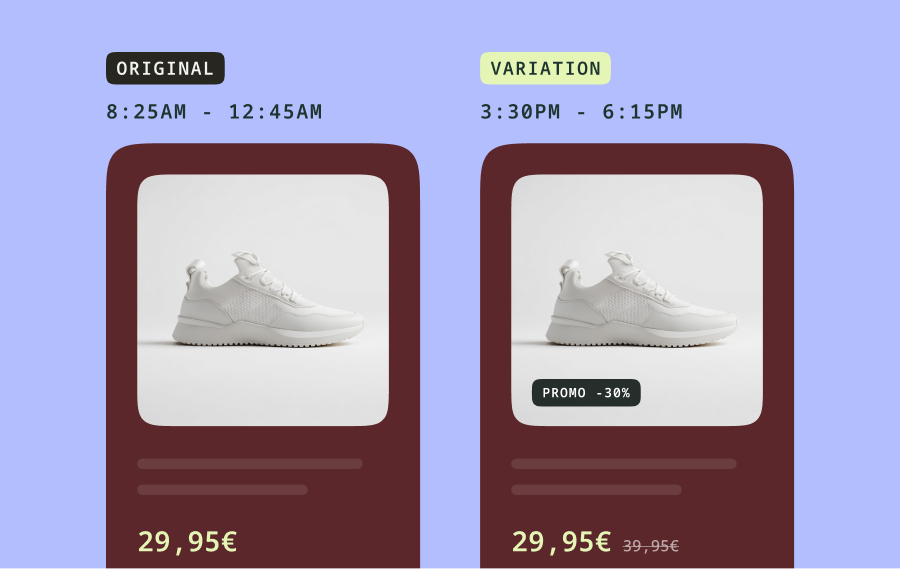Why is my Marketing-Led Growth (MLG) strategy not working?

Marketing-led growth (MLG) strategies often fall short because teams are siloed. When marketing, product, sales, and customer support work separately, their decisions become fragmented and hard to align with the broader business strategy.
Siloed teams can also miss opportunities to innovate. A/B testing and experimentation results that might not be exciting to a product team could be transformative to a marketing team.
An MLG strategy works best as part of broader collaborative business growth strategies. One effective approach is to coordinate experimentation across all of your teams that yield the most meaningful results for everyone.
What is Marketing-Led Growth (MLG)?
Marketing-led growth (MLG) is a business growth strategy focusing on marketing initiatives as the main driver for customer acquisition and retention. Companies following an MLG strategy focus their business development efforts on showcasing the value of their products to existing and prospective customers and increasing brand awareness.
MLG strategies are data-driven and involve extensive testing and experimentation. The goal is to attract not simply more users but the right users. Effective marketing-led growth strategies have strong user acquisition, retention, and customer lifetime value (CLV).
What does an MLG strategy look like?
Most MLG strategies involve a similar set of core practices. These are some of the most common benefits of marketing-led growth.
Data-driven optimization
By leveraging analytics and testing data, businesses gather valuable information about consumer behavior, preferences, and their marketing campaigns’ performance. An MLG strategy allows for informed decision-making and helps businesses optimize their marketing, sales, and other activities for maximum impact.
Just a few examples:
- Personalization. Using experimentation data, marketers can personalize content and offers based on user behavior, preferences, and demographics. They can optimize any campaign they care about, email marketing, website content, or targeted ads.
- Optimize ad spends. Based on the results of A/B testing or other tests, marketers can optimize their ad budgets by identifying the best-performing channels, keywords, and audience segments.
- Segmentation. You can analyze customer data to segment the audience into distinct groups based on engagement behaviors, preferences, and purchase histories.
Customized engagement strategies
Teams following an MLG strategy make a concerted effort to customize the engagement each audience segment receives. One audience may be high-touch, another low. And each will receive its personalized content, targeted communication, and relationship-building initiatives.
Strong brand identity
MLG strategies require a compelling brand identity that captures the essence of the business and builds a strong connection with the target audience. Trust and brand recognition are developed through consistent messaging and a brand persona that aligns with the audience's values.
Enhanced product visibility
MLG initiatives value using targeted content creation and presence in channels relevant to your audiences. These initiatives aim to position their products in the market and generate interest among their target audiences.
Emphasis on top-of-funnel interactions
Providing valuable information, addressing your audiences’ pain points, or offering engaging content helps businesses improve lead acquisition. That sets the stage for deeper relationships as customers move through the funnel.
Applying these ideas can create a self-perpetuating marketing-led growth flywheel that leads from one set of new customers to the next.
Common challenges applying an MLG strategy
True to its name, a marketing-led growth strategy helps spread your product message to wider audiences quickly and effectively. But its emphasis is squarely on the audience and that messaging. If unprepared, this hyper-focus can create challenges for teams trying out an MLG strategy.
Lack of product control
Marketing teams often have limited influence on product development, making it harder to adapt the product when new market opportunities or customer needs arise. So, while you can reach new markets, adapting your product to fit those markets might be challenging without broader strategizing.
Knowledge gaps
Specialized software and other tools typically require specialized marketing, IT, or other domain-specific knowledge. The tools used in a hyper-focused MLG strategy may not be usable or applicable for people outside of the immediate team.
Less able to adapt the product to new markets
As businesses expand, they inevitably must search for new markets. Those markets likely have unique needs. You may be well-positioned to tailor messaging, but without the ability to tailor the product, new marketing efforts may fall flat when the product fails to resonate.
Misalignment with the product team
Refining and improving a product based on market demands becomes difficult without continuous feedback loops and collaboration. What needs to be added is a cohesive approach that integrates marketing insights with product development. You must ensure the product evolves in response to feedback and market trends.
Common product issues that can affect an MLG strategy
An MLG strategy can be a highly effective means to generate growth. Understanding the potential issues you might encounter will help you finetune your MLG processes.
- Lower-quality product. Negative feedback can quickly counter even the strongest messaging. If the product has significant flaws, it will lead to negative reviews and decreased customer retention, regardless of the marketing strategy.
- Poor market fit. Even with strong messaging, if the product does not address the target market's needs, it will struggle to gain traction. Insights generated through market research can help reveal what prospective customers might want or not want in an unfamiliar market.
- Lack of differentiating features. It takes a concerted effort of product and marketing teams to create a unique product and to communicate that unique advantage to new customers.
- Overselling or underselling. Overselling sets unrealistic expectations, leading to customer disappointment and churn. Underselling a product can lead to missed opportunities to attract potential customers when they don’t understand its full value.
To overcome these challenges foster collaboration between marketing and product teams. Ensure your teams clearly understand the target market and use that knowledge to adapt the product based on feedback and data-driven insights.
The case for web experimentation
Web experimentation is one of the most important marketing-led growth tools in your toolkit. Marketers can determine what resonates most with users by testing different layouts, messages, and designs on specific audience segments. This allows for continuous improvement of the website and marketing campaigns based on real user feedback and behavior.
By running controlled experiments, marketing teams can understand which changes have the most significant impact on user engagement and conversion rates. The insights generated through experimentation inform how to tailor marketing efforts to meet audiences' needs.
Why do marketing leaders prefer web experimentation?
Web experimentation, including A/B testing, allows for incremental and evidence-based improvements. Web experimentation's structured, iterative nature ensures that only the most effective changes are implemented. Marketers can fine-tune their materials without the risk of overhauling entire systems based purely on assumptions.
Web experiments are also easy to get up and running. If a team member is doing CRO and they have data on a hurdle they want to test, they can quickly deploy an A/B test to see which leads to more conversions. If someone else wants to test personalized landing pages, they can easily set up a test based on whatever segments a web experimentation tool can track.
Where is the friction with product teams?
Web experimentation can sometimes create friction between marketing and product teams despite its benefits. One common issue is the misalignment of priorities. Marketing teams might push for rapid experimentation and changes to meet campaign goals, while product teams may prioritize long-term stability and user experience.
Marketing teams' lack of direct control over the product can also lead to challenges in implementing and testing new features or designs in real time. Without adequate coordination, or access to simple shared tools, marketing needs to rely on product for feature flag testing for different markets or other marketing objectives.
How All-Team Experimentation stops the struggle of product-led growth vs. marketing-led growth
All-team experimentation—also called hybrid experimentation—combines feature and web experimentation. Marketing, product, and other teams work in a unified environment, sharing datasets and experiment repositories. This prevents redundant testing efforts, ensures transparency, and provides both teams access to each other's insights.
The goal here is to break down silos and maximize collaboration. Marketing teams benefit from a product optimized for their audience, while product teams gain access to optimized marketing channels to drive conversions.
The role of AI in facilitating All-Team Experimentation
AI now has an important role to play in all-team experimentation. It’s best thought of not as a tool but as a dedicated copilot. New experimentation AI will help coordinate your strategy's many moving parts, ensuring seamless planning, execution, and analysis.
In all-team experimentation, all team members must coordinate their actions. Everyone must draw insights from unified, high-quality data sources. That includes your AI team members too.
High-quality data also provides context for everyone. With good context, AI helps its team prioritize the right experiments based on historical and real-time data and current business objectives.
Connecting AI to relevant data also enhances its collaborative capabilities. Doing so allows the AI to help align your experiments to meet strategic KPIs better.
When adding AI to your experimentation team, focus on the principle of "quality in, quality out" for your data. Ensure your AI team member can access relevant data as easily as your human team members to understand everyone's objectives. Your AI can then suggest ideas for testing and guide users on the best methods for analyzing their experiments and improving outcomes.
Kameleoon’s commitment to All-Team Experimentation
We’re committed to pushing the boundaries of what is possible with all-team experimentation. Kameleoon is the only optimization solution that allows you to leverage experimentation, AI-powered personalization, and feature management capabilities in a unified A/B testing platform. Teams can use Kameleoon to build hybrid experiments, build no- or low-code server-side tests without a developer, and generate web-based data for targeting and analytics.
By making it easy to implement both MLG and PLG principles within individual teams and throughout your organization, we ensure that your experimentation programs are efficient, data-driven, innovative, and adaptive to market needs. With Kameleoon, you have a partner committed to transforming your experimentation efforts into strategic advantages.
Learn how Kameleoon Hybrid can drive your all-team experimentation strategy




